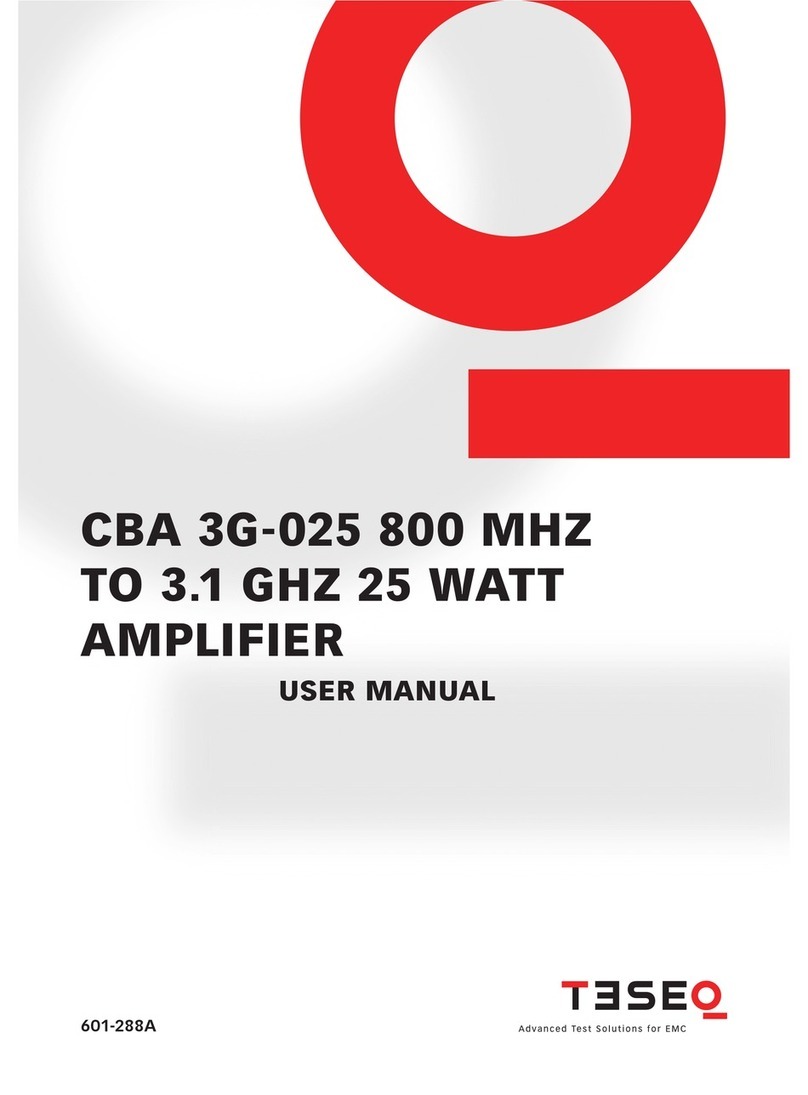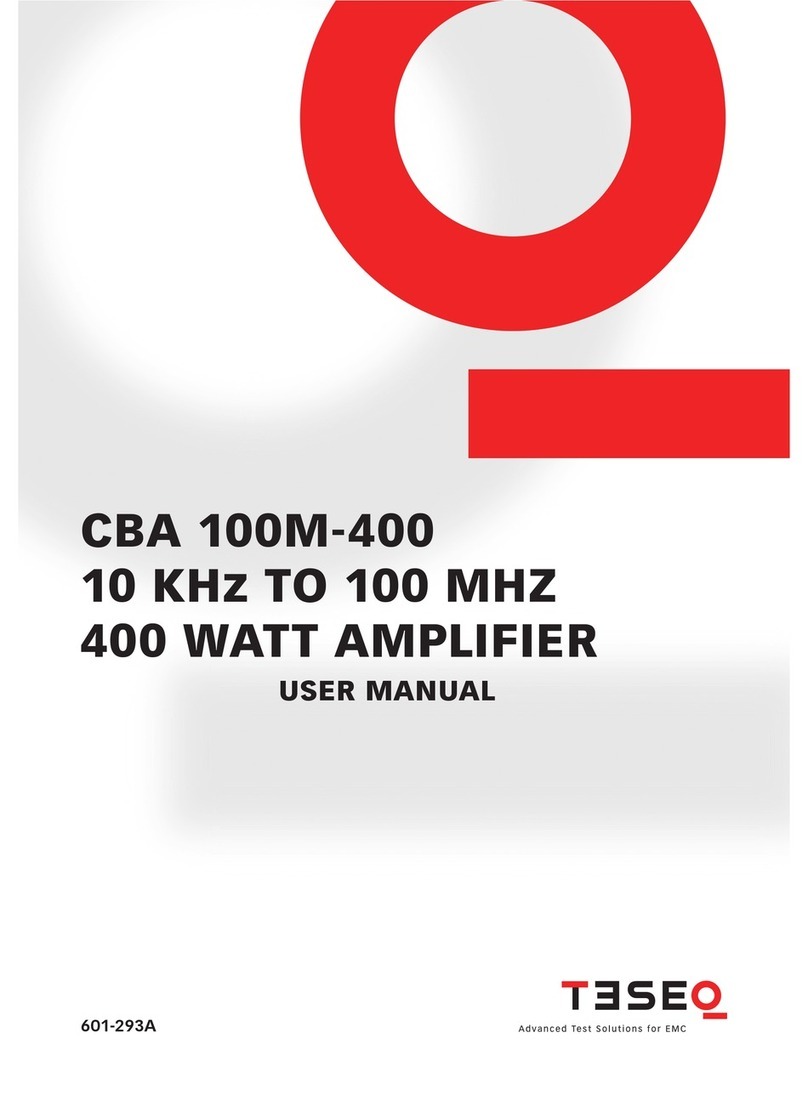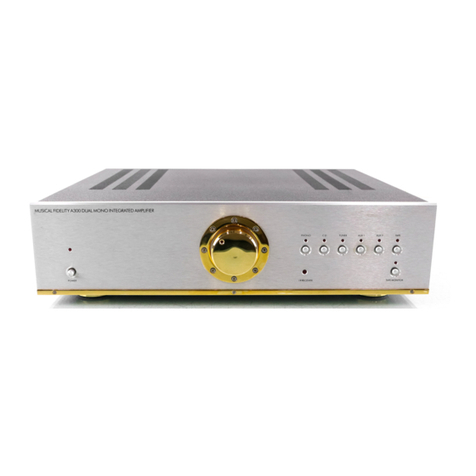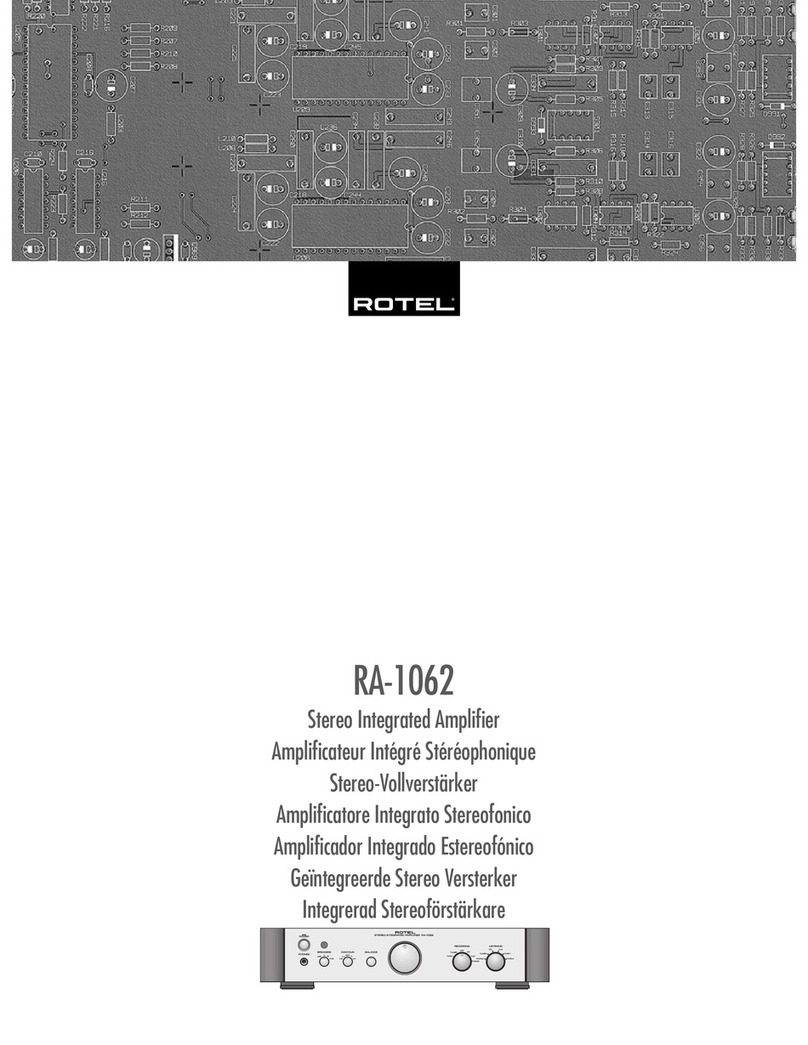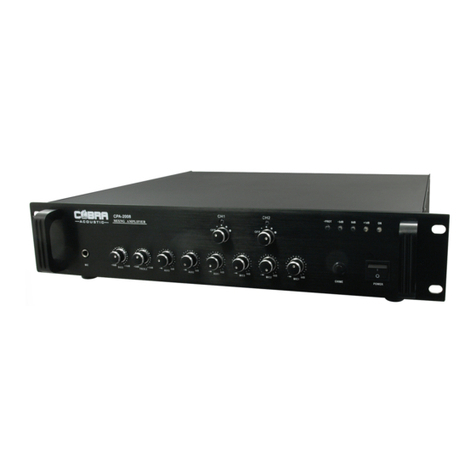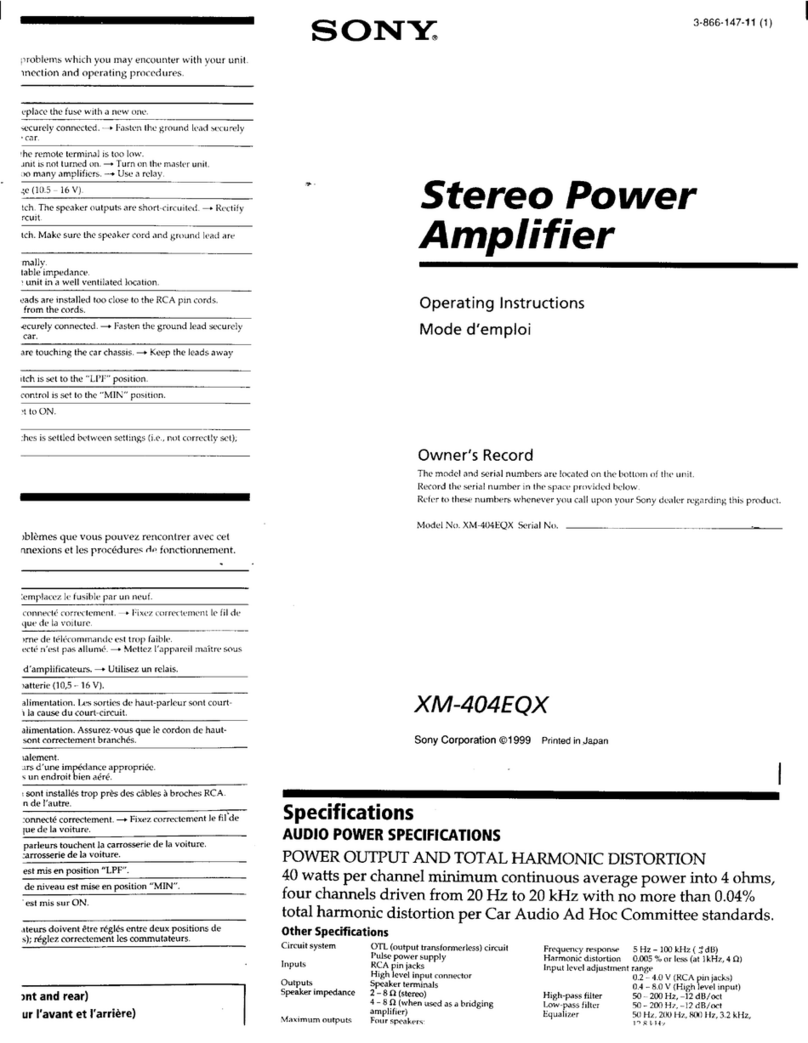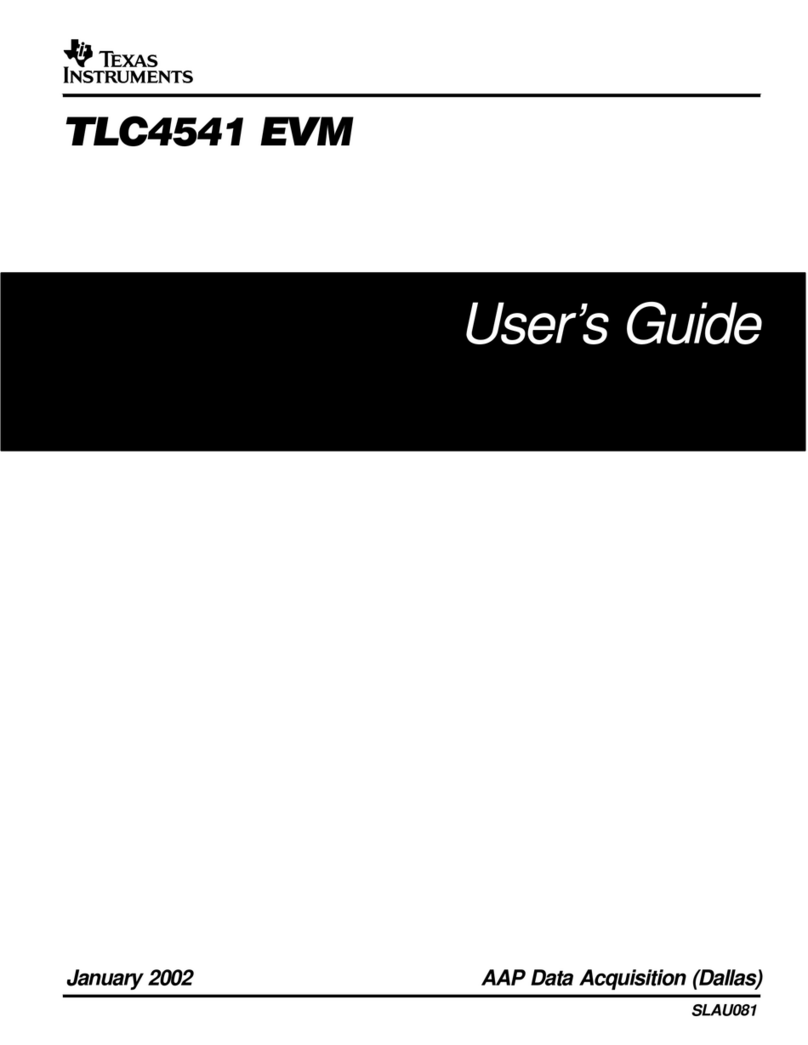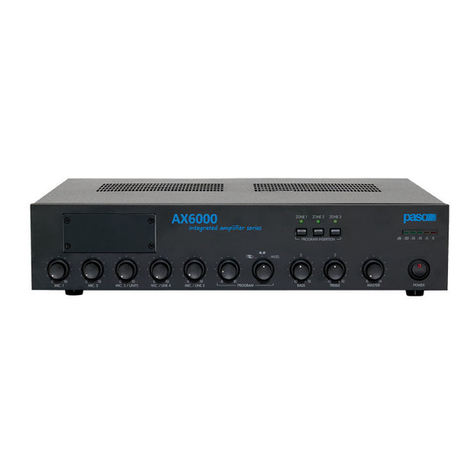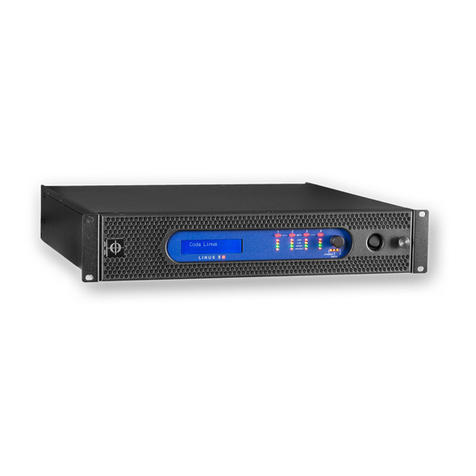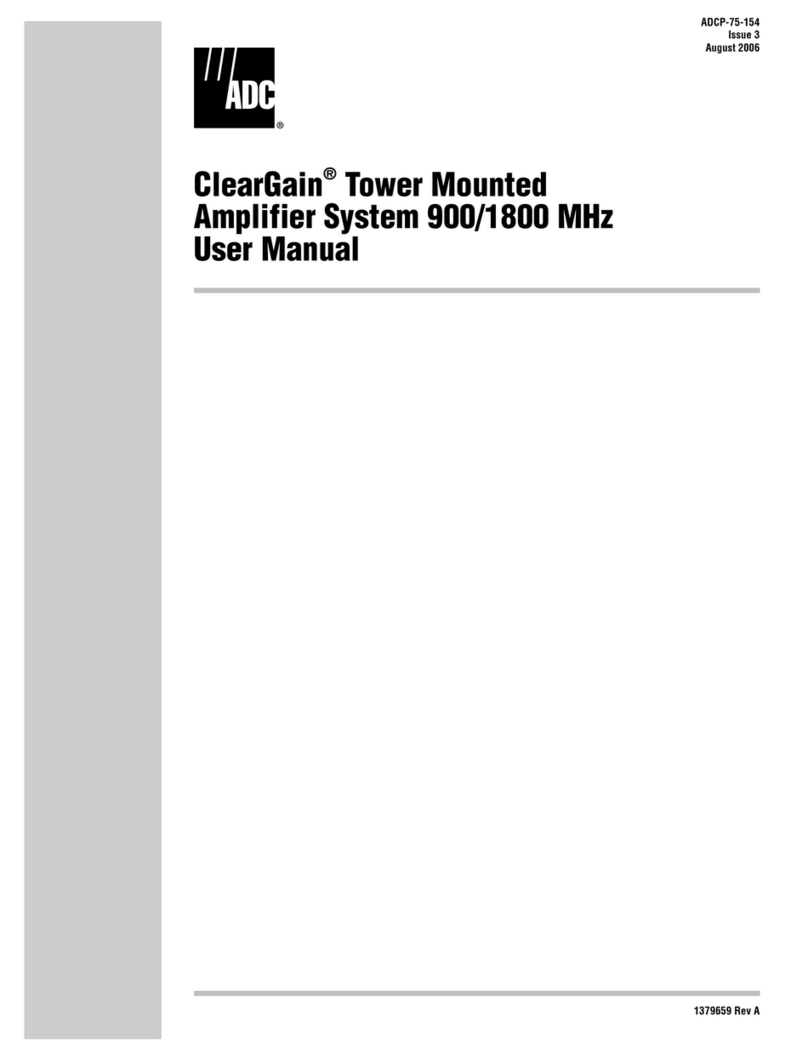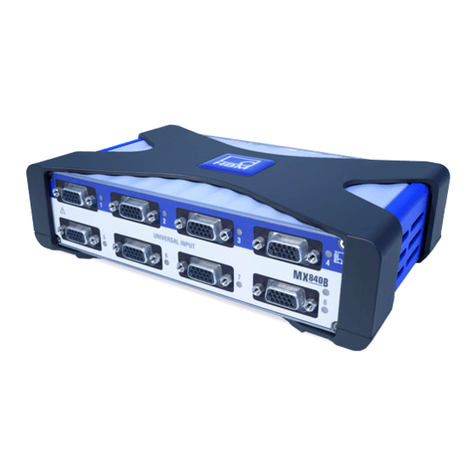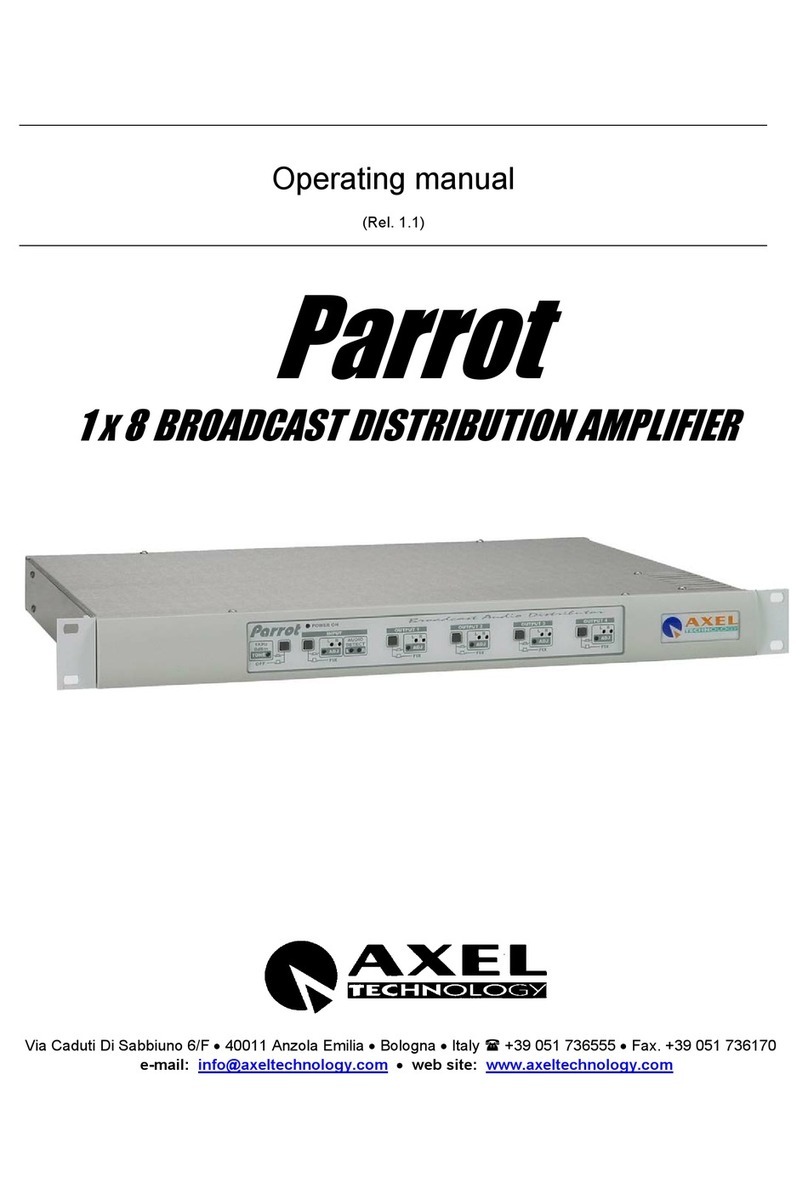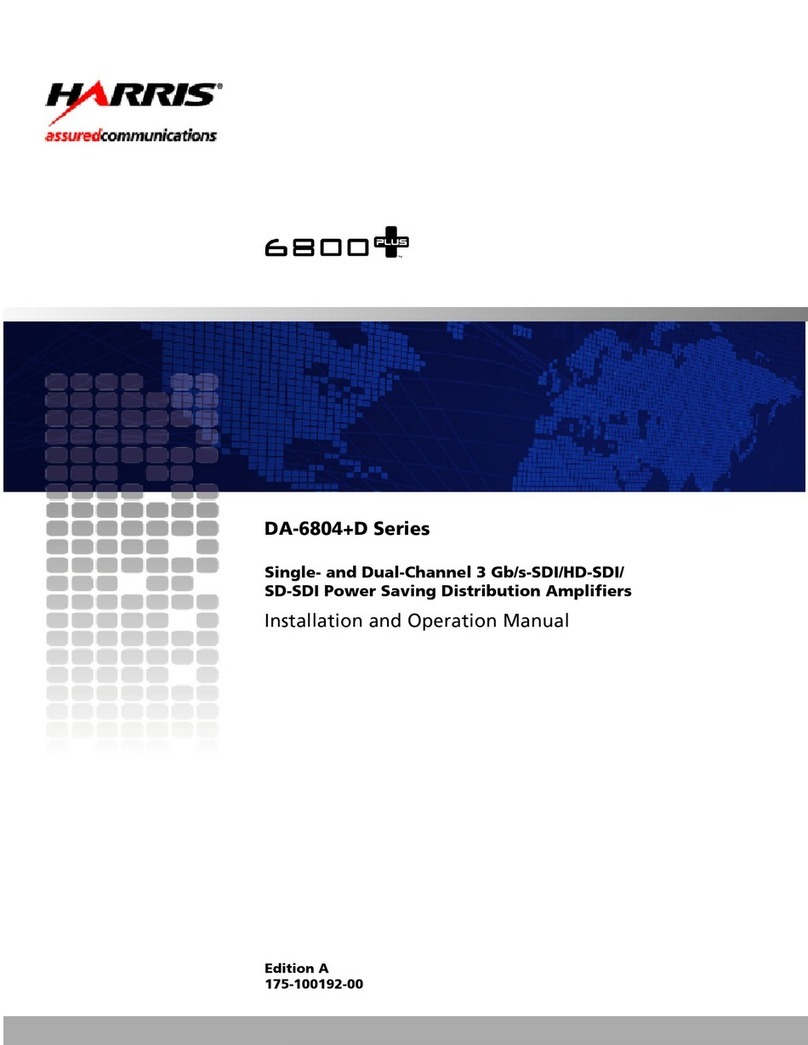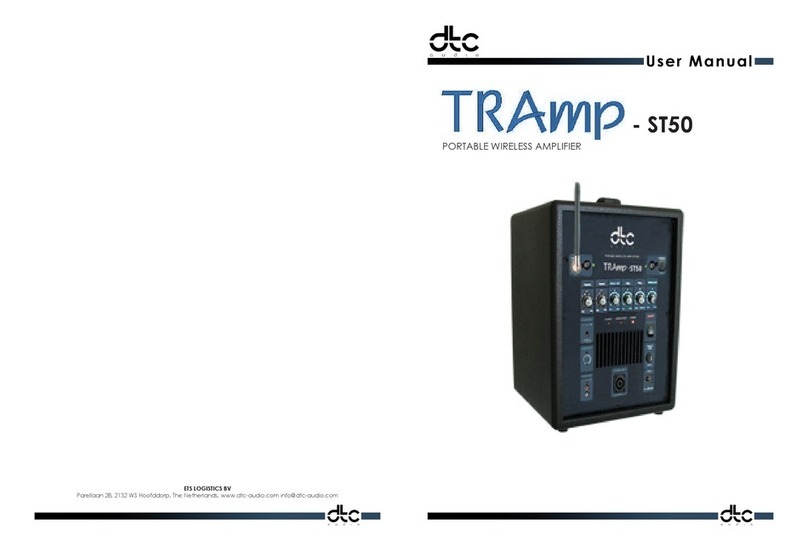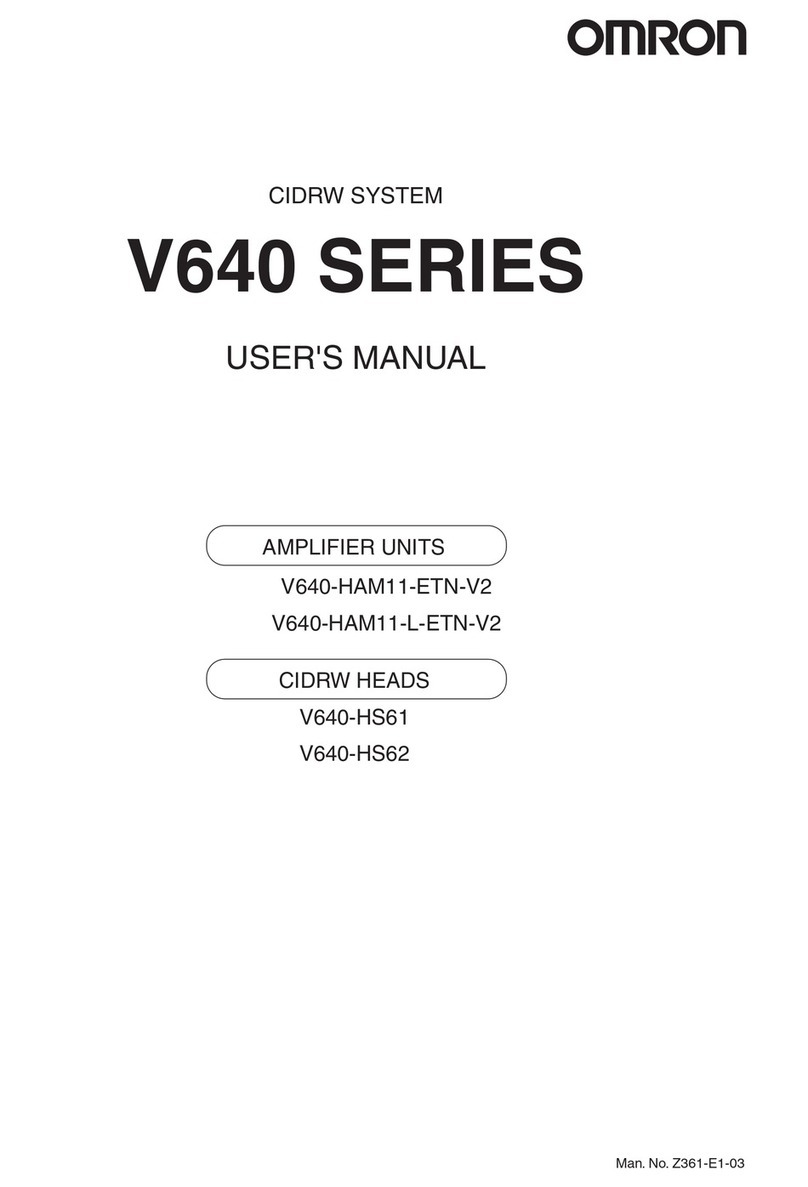Teseq PA 5740 User manual

1
PA 5740 - Automotive
bAttery simulAtors
user mAnuAl
601-309A
Advanced Test Equipment Rentals
www.atecorp.com 800-404-ATEC (2832)
®
E
s
t
a
b
l
i
s
h
e
d
1
9
8
1

PA 5740 - Automotive battery simulators
PA 5740 - Automotive
bAttery simulAtors
user mAnuAl

1 The PA 5740 Automotive battery simulator 5
1.1 Introduction 5
1.2 Features 6
2 Safety instructions 7
2.1 Danger classication 7
2.2 Pictograms on Test System 8
2.3 Excess voltage category 9
2.4 Application area 9
2.5 Safety of operation 9
2.6 Operating personnel 10
2.7 Persons responsible for safety measures 10
2.8 Accident prevention regulations 10
2.9 Infringement of safety regulations 10
2.10 Proper use 10
3 Installation/Set-Up 11
3.1 Checking the shipment 11
3.2 Delivery contents 11
3.2.1 Standard accessories 11
3.2.2 Documentation 11
3.3 Set-Up 11
3.3.1 Operating position 12
3.3.2 Line voltage connection and grounding 12
3.4 PA 5740 Front panel connectors 13
3.4.1 The control connector 13
3.4.2 The output connectors 15
4 Operation 16
4.1 The compensation button 16
4.2 The gain button 17
Contents

44.3 The current limit LED 17
4.4 The errors LEDs 17
5 Applications 19
5.1 Compliant with ISO 7637 (and similar) for transient immunity 19
5.2 Voltage variations for starting proles 19
5.3 Fast rise time for challenging voltage dip applications 20
5.4 Voltage ripple and sine wave noise simulations 20
5.5 Example application with NSG 5500 and NSG 5600 21
6 Maintenance 22
6.1 Cleaning the equipment 22
6.2 Moving and storing the amplier 22
6.3 Protection 23
6.3.1 Fuses 23
7 Specications 27
7.1 Environmental conditions 27
7.3 Pictures 30
7.3.1 Front view 30
7.3.2 Rear view 30
8 Declaration of conformity (CE) 31
9 Addresses 32

5
1.1 Introduction
The PA 5740 range of battery simulators is high performance power ampli er
providing a stable and rugged power source for laboratory applications. The
ampli er has been designed speci cally to simulate battery supplies. Such as
12, 24 and 42 V vehicle electrical systems. It may be used on its own or inte-
grated with the Teseq Automotive EMC Test System consisting of NSG 5000,
NSG 5200, NSG 5500, NSG 5600 (hereafter referred to as NSG 5000 series)
and AutoStar software.
Designed to meet EMC (electromagnetic compatibility) immunity testing require-
ments for the automotive industry. Applicable standards include: ISO 7637,
ISO 16750, JASO D001, MIL-STD-461E, SAE J1113 as well as automobile manu-
facturer speci cations.
Types of testing include supply voltage variations, dips and drops, ISO pulses
2b and 4, load dump pulse, starting pro les, power cycling, battery recovery,
reset behaviour, fuel pump transient, conducted sine waves, ground shift, jump
start and over voltage, as well as providing a programmable DUT (device under
test) power source during all phases of testing.
1 tHe PA 5740 Automotive bAttery
simulAtor

6
PA 5740 - Automotive battery simulators
1.2 Features
The output is programmable over a minimum voltage range from - 60 to + 60 V
which allows the simulation of a large range of pulses and voltage variations. A
remote sensing input is provided to compensate for output cable voltage drop
(up to 4 V). The output provides a wide bandwidth (DC to >150 kHz), a fast output
slew rate and low source impedance (<10 mOhm).
All controls, displays and connections are located on the front panel for ease of
access and visibility except the output connectors which are even located on
both the front and the back panel. These facilities include: voltage input; current
limit input, current limit indicator, current and voltage display, compensation
mode, gain setting and output and sense connectors.
The voltage and current control and monitoring interface is realized with an
integrated control D-type connector for direct connection to the Teseq NSG
5000 series.
The amplier inputs are over voltage protected and outputs short circuit pro-
tected. The mains input voltage is selectable by Teseq factory/service points to
accept world voltage supplies and is under voltage protected. Overtemperature
protection is monitored on the internal heat sink and transformer.
There are three selectable ranges for compensation/bandwidth for the
PA 5740. Bandwidths are high, allowing fast slew rates as required by numerous
standards. The current limit is programmable from 10 to 100% of the output
current capability.

7
Be sure to observe the following safety precautions before you install the test
system and put it into operation!
Also follow all safety instructions in the manuals of the connected peripheral
devices.
2 sAFety instuCtions
NOTE!
Always keep operating instructions for future use!
Store the operating instructions so that they are always
accessible to all operating personnel.
Every operator must be informed exactly where the
operating instructions have been stored.
2.1Dangerclassication
The safety precautions in the manual are always presented in the same format.
They consist of the signal word, which contains information on the type and
source of the danger, an explanation of the preventative measures to be
taken and a standard warning symbol.
The following table gives you an overview of the signal words used, their alloca-
tion to speci c dangers and their possible consequences.

8
PA 5740 - Automotive battery simulators
Warning
symbol Signal word Denition
DANGER!
There exists a high risk of fatality or severe
injury if the necessary preventative measures
are not taken.
WARNING!
Potentially dangerous situation that can result
in injuries and serious damage to equipment if
the necessary preventative measures are not
taken.
CAUTION!
Situations that could arise when objects or
equipment are damaged if no measures are
taken to prevent this.
NOTE! Information on important special features.
TIP! User tips and information.
2.2 Pictograms on Test System
Various warning symbols are applied to the test system. The following table
provides you with an overview of the assignment of symbols (pictograms) and
signal words to the specic danger.
Pictogramm Denition
Possibly dangerous situation that can result in injuries
and serious damage to the equipment.
Situation that can result in damage to the equipment.

92.3 Excess voltage category
The test equipment PA 5740, as described in this manual, is related to the
excess voltage category II according IEC 60664.
2.4 Application area
These instructions apply to the entire system. Other safety regulations for com-
ponents used or devices additionally installed in the test system are not voided
by these instructions and are to be followed.
2.5 Safety of operation
Reliable function and safe operation of the test equipment are ensured only if
the relevant general precautions as well as all safety instructions given in this
manual are observed.
In particular, observe the following:
Connect the device only to line voltage that conrms to the power speci-
cation given on the type label (on the back of the test equipment).
Do not touch any conductive parts at the output connectors, the xture and
the test object during a test run.
Disconnect the device from the mains before opening the casing for
maintenance or repair.
During the operation of the test equipment always observe the relevant rules
of ESD (Electro Static Discharge) protection.
To guarantee the EMC features of the device, the control computer must
meet the requirements of the EN 50082, EN 55011, EN 61000 standard.
Make sure the environmental conditions described in chapter 7.1 Environ-
mental conditions exist.

10
PA 5740 - Automotive battery simulators
2.6 Operating personnel
The test system should only be operated by qualied personnel. Making set-
tings, maintenance work and repairs on an opened device can only be carried
out by the appropriately trained personnel. Teseq and its representatives will
only guarantee for maintenance and repair when it has been carried out by its
own service personnel.
2.7 Persons responsible for safety measures
Those considered responsible for safety are the owner, the user and the opera-
tor. In addition, you are responsible for all safety measures that are indirectly
linked to the test system. More relevant information can be found in the acci-
dent prevention regulations. Also observe all the safety measures for additional
devices used together with the test system.
2.8 Accident prevention regulations
When dealing with the test system observe the industrial health and safety
standards pertaining to electrical test installations in your country.
2.9 Infringement of safety regulations
If the system is not functioning as described or is visibly damaged, this can affect
its safety status. If this is the case the system must be shut down immediately,
and in such a way that it cannot be started up again accidentally by any third
persons. Please inform the Service Department at Teseq or its representative.
2.10 Proper use
The test system is exclusively for the testing of electrical devices and compo-
nents in accordance with the test system specications.

11
3.1 Checking the shipment
3 instAllAtion/set-uP
Upon receiving the shipment, rst check the packaging and outer equipment
for visible damage. Also, check packaging and casings of peripherals (if any).
Record in writing any defects which were possibly caused in transit. If the
shipment shows damage or is not complete, immediately advise the shipping
agency and/or your dealer.
3.2 Delivery contents
The standard delivery contains the basic unit as well as several attachments
and accessories.
3.2.1 Standard accessories
One power cable
3.2.2 Documentation
The following manuals are supplied:
This PA 5740 Automotive battery simulators hardware guide
3.3 Set-up
CAUTION! Risk of damage by condensation!
When the equipment is brought from cold to warm
environment, a dangerous conditions can result from
condensation.
Do not operate the system until all parts of the system
have reached room temperature.

12
PA 5740 - Automotive battery simulators
3.3.1 Operating postition
3.3.2 Line voltage connection and grounding
CAUTION! Risk of destruction by wrong main voltage!
Ifthevoltagespeciedonthetypelabel(onthebackof
the equipment) does not agree with the voltage in your
local mains supply, the tester can be destroyed.
Makesurethevoltagespeciedonthetypelabelofthe
power supply agrees with your local mains voltage.
Do not use power supplies that deliver output voltage
other than 100 V/12,5 A, 120 V/10 A or 230 V/6,3 A.
The power cord of the equipment is located on the back of the equipment. The
power input is secured with a delayed action fuse (for details, refer to chapter
5.3 Protection).
The power plug and outlet must have grounding contacts.
The equipment may be set-up by qualied personnel only.
It is imperative to observe the safety instructions at the beginning of this
manual.
The equipment will be safe to operate and perform to its specications only
under the environmental conditions found in chapter 7.1 Environmental condi-
tions.
The tester must be placed in upright position rmly and securely during opera-
tion. There must be enough space around the equipment to ensure a sufcient
air ow for cooling. The ventilation grilles must be kept free.

13DANGER! Danger to life by interruption of the grounding!
If the grounding is interrupted inside or outside the
equipment, the PA 5740 will become a source of
danger.
Follow the regulations for the grounding of the
system.
3.4 PA 5740 Front panel connectors
3.4.1 The control connector
The “CONTROL” connector is an input port for the function generator; it can
be directly connected to the appropriate connector at the function generator
card of your NSG series.
To benet from all advantages of the PA 5740 it is best controlled by your NSG
5000 series. But of course if the specications described in chapter 3.4.1.2
CONTROL input specications are considered, the PA 5740 can be controlled
by any other analog function generator as well.

14
PA 5740 - Automotive battery simulators
3.4.1.1 Pin count of the control I/O DSub connector
3.4.1.2CONTROLinputspecications
The Vprog+ pin of the connector is the voltage Input of the battery simulator.
The output of the battery simulator can be described as U OUTPUT = Vprog+x
GAIN. The GAIN can either be set to 7 or 1.
Ilim+is the analog control of the current limit. The input is 1-10 V which equals
a current limit of 1-10 A.
CAUTION! Risk of destruction by wrong voltage!
If the PA 5740 is controlled by any alternative function
generator it care has to be taken that the voltage at the
Ilim+ pin must be at least +1 V.
Make sure the voltage at the Ilim+ pin is at least +1 V.

153.4.2 The output connectors
3.4.2.1 The power output connectors
The “POSITIVE/NEGATIVE POWER” connectors are used to connect the output
to the DUT or to the NSG 5000 series.
NOTE!
Information about the power output connectors:
See the hardware guide of the appropriate test system
for more details.
3.4.2.2 The sense output connectors
The “SENSE” connectors may be connected to compensate for voltage drop of
the cables to the DUT or to the NSG 5000 series.
The output connectors of the PA 5740 series (front)
The output connectors of the PA 5740 series (back)

16
PA 5740 - Automotive battery simulators
4.1 The compensation button
4 oPerAtion
Risk of destruction of the DUT or couplers!
Monitor the DUT to ensure no ringing or excessive over-
shoot is present.
In case there is a question you should use the CAPACI-
TIVE mode.
Pressing this button toggles between the available compensation modes:
STANDARD This is the normal operating mode with a good com-
promise between stability and bandwidth. The bandwidth
in this selection is approximately 40 kHz
CAPACITIVE This mode is specically designed for capacitive and/or
reactive loads. This reduced bandwidth, high stability
mode is perfect for using during normal transient testing,
conducted sine wave (CSW) testing. The bandwidth in this
mode is limited to approximately 3 kHz.
HIGH FREQ This mode is for testing where high bandwidths are
required. This mode allows frequencies up to 150 kHz.

174.2 The system stop button
This button toggles between the available gain options of the amplier:
GAIN HIGH (x7) Indicates a gain of seven. 1 V in will result in 7 V output
voltage.
GAIN LOW (x1) Indicates a gain of one. 1 V in will result in 1 V output
voltage.
4.3 The CURRENT LIMIT LED
This LED indicates that the current limit has been reached.
4.4 The ERRORS LEDs
POWER FAIL This LED indicates if any of the system voltage check fails.
It is blinking in case the power stage power supply unit
fails and it stays constant if the auxiliary supply fails.

18
PA 5740 - Automotive battery simulators
OVERTEMP This LED blinks as a warning that the internal operation
temperature is reaching a critical range. It stays constant
if the operation temperature exceeds the critical range
and the amplier switches off the output signal but keep
on the fan to cool down the amplier.
NOTE!
The active COMPENSATION and the active GAIN LED are
blinking additionally.
If the output signal is switched off because the amp-
lierdetectedovertemperatureorapowererrorthe
active COMPENSATION LED and the active GAIN LED are
blinking additionally.
NOTE!
Operation temperature.
If the operation temperature returns to the safe range,
the output will switch back on automatically.
NOTE!
LED test.
During system power up the LEDs will be tested for
approximately one second.

19
5.1 Compliant with ISO 7637 (and similar) for transient immunity
The PA 5740 is designed to act as the battery source for transient immunity
tests. Most transients must be coupled onto battery voltage and the NSG 5000
series with its internal coupling couples the transient and the DC voltage as
required by the standards. Designed with low internal resistance and low noise,
the PA 5740 is compliant with section 5.4 of ISO 7637-2:2004.
For this application please use compensation mode CAPACITIVE.
5 APPliCAtions
5.2 Voltage variations for starting profiles
The PA 5740 series is often used for starting prole simulation (pulse 4 and
variants). In addition, several standards require synchronized starting proles.
Utilizing the NSG 5000 series for control, the PA 5740 (or the PA 5840) is the
best solution for all known starting proles with up to four synchronized starting
proles. The PA 5840 is another automotive battery simulator from Teseq but
for greater power. See the specications of the NSG 5000 series for details.
For this application please use compensation mode CAPACITIVE.
UA
0

20
PA 5740 - Automotive battery simulators
5.3 Fast rise time for challenging voltage dip applications
Certain standards, such as Ford ES-XW7T-1A278-AC specify ~10 μs rise and
fall times for the battery simulator. The PA 5740 is designed to fully meet the
relevant standards and is often used for dips and drops applications where
<10 μs rise times are specied.
For this application please use compensation mode STANDARD.
5.4 Voltage ripple and sine wave noise simulations
The PA 5740 is also commonly used to simulate sine wave noise on battery
voltage. A user could, for example, simulate a 1 V p/p sine wave onto a 42 V
network using high battery current. This is a common requirement of manufac-
turers’ standards. For this application please use suitable compensation mode
(as frequency required).
UA
0 V
Table of contents
Other Teseq Amplifier manuals

